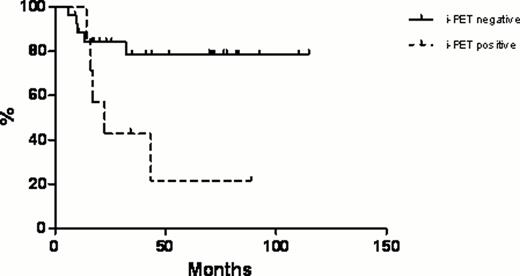Abstract
Abstract 2721
Role of interim- and final-PET in peripheral T-cell lymphoma (PTCL) is quite unknown. To determine predictive value of PET on overall survival (OS), we evaluated interim-PET (i-PET) and final-PET (f-PET) in PTCL patients treated in first-line with 6 CHOP-21 courses. From September 2003 to July 2010 we diagnosed and treated in our institution 34 advanced stage PTCL patients (15 females and 19 males). The median age at diagnosis was 46 years (range, 21–81 years); 9 patients were in stage III, and 25 in stage IV. According to the histologic subtype there were 11 PTCL-nos, 6 AILT, 9 ALCL Alk+, 6 ALCL Alk-, and 2 NK/T nasal type patients. Four patients had bulky disease; eight patients had bone marrow involvement, 15 patients had 1 extranodal involvement and 10 had more than 2 extranodal sites. All patients underwent initial staging PET/CT; i-PET was performed after 3 cycles of CHOP-21 and the median time from the end of third course to i-PET was 14 days (range, 7– 18 days). f-PET scans were performed 35 days (range, 30– 45 days) after the end of therapy.
The table summarizes the correspondence between i-PET and f-PET results:
| N=34 . | . | f-PET negative, n (%) . | f-PET positive, n (%) . |
|---|---|---|---|
| i-PET negative | 27 | 19 (70.4) | 8 (29.6) |
| i-PET positive | 7 | 1 (14.2) | 6 (85.8) |
| N=34 . | . | f-PET negative, n (%) . | f-PET positive, n (%) . |
|---|---|---|---|
| i-PET negative | 27 | 19 (70.4) | 8 (29.6) |
| i-PET positive | 7 | 1 (14.2) | 6 (85.8) |
With a median follow-up of 71 months (range, 5.8–120.9 months), 17/19 (89.5%) patients with i-PET negative are in continuous CR (CCR) and only 1/7 (14.2%) patient with i-PET positive is still in CCR. Figures show the overall survival (OS) according to response at i-PET and f-PET. In figure 1a we observe OS plotted according to i-PET results: 78.6% for negative patients (solid line) and 21.4% for positive patients (dashed line) at 88.7 months (p=0.02); in figure 1b we observe OS plotted according to f-PET results: 93.7% for negative patients (solid line) and 21.4% for positive patients (dashed line) (p<0.0001).
In conclusion, our results demonstrate that positive i-PET is not predictive of a worse outcome in PTCL. On the contrary, the f-PET seems to represent a significant step forward in the prediction of survival for these patients. Larger and prospective studies and harmonization of PET reading criteria are needed.
No relevant conflicts of interest to declare.
Author notes
Asterisk with author names denotes non-ASH members.



